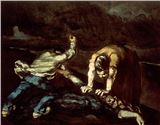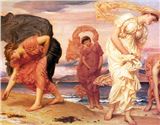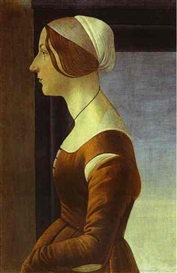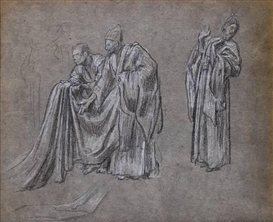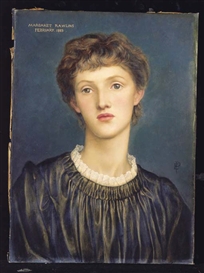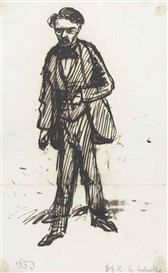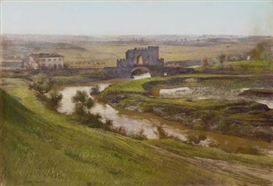The Pre-Raphaelites and Their Predecessors
A conversation between Italian masters and the Pre-Raphaelite Brotherhood reveals a continuity of themes, shared influence, and profound respect
Michael Pearce / MutualArt
Apr 19, 2024
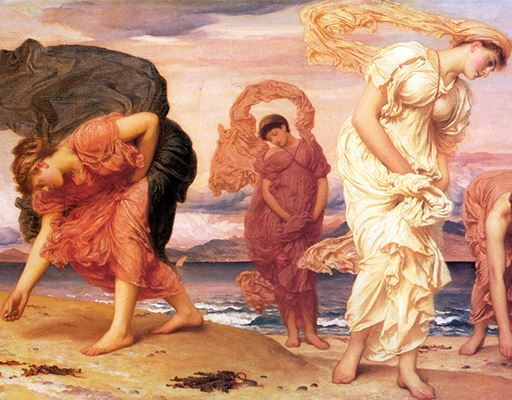
On a wall among the hushed halls of a late medieval Dominican convent in Forlì, near Bologna, you will find the image of a group of four barefoot and beautiful young women eternally gathering pebbles from the seashore, caught in the gestures of bending to retrieve their trivial treasures from the sand and scattered seaweed. Their poses are languid and lovely, and they move through the golden light that forms dreams of heaven, dressed in fantastic billowing sheets of faded pinks and pale russet, sunny cream and darkened indigo, cloths twisting and filling in the breeze rolling in from the warm sea – the fabric balloons in impossible, luxurious fantasias of wonder and form, spilling into rippling twists and loops of contoured folds, more tidal than the temperate waves of the Aegean, which break gently on the golden shore. They are born from three great ages of feminine beauty: the classical days of the ancients, when idealized women were goddesses, awesome, petty, and divine; the renaissance revival, when the artists learned the elegance of allegory; and the era of romance, when love and laudanum held their hands and hearts.
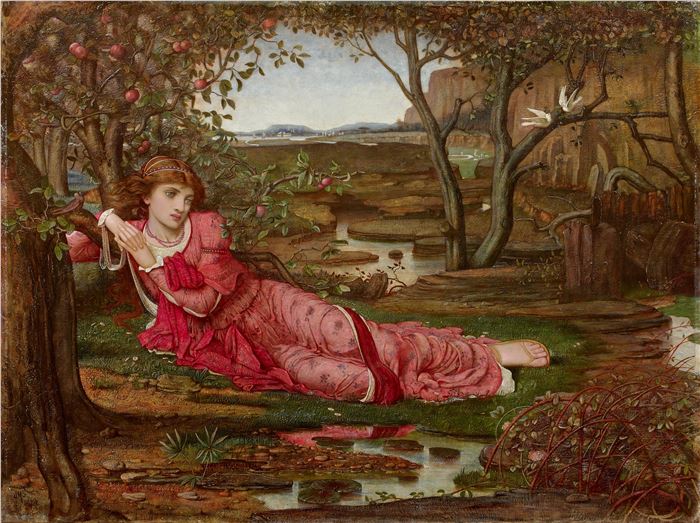 John Strudwick, Song without Words, 1875, oil on canvas, 74.3 x 99.8 cm, Collection of Pérez Simón.
John Strudwick, Song without Words, 1875, oil on canvas, 74.3 x 99.8 cm, Collection of Pérez Simón.
The painting did not spring from the imagination of an Italian genius, but from the mind of an Englishman – it is Frederic Leighton’s Greek Girls Collecting Pebbles on the Seashore, a wonder of the Victorian artist’s work from the Long Island collection of Pérez Simón. Like all of the Pre-Raphaelites and their admirers, Leighton loved Italy, especially the 15th-century art that dressed the renaissance in delight, visiting repeatedly for forty years. Now, his work has come to Forlì in a superb and historic exhibit gathering magnificent paintings, tapestries and drawings by the Pre-Raphaelite Brotherhood and their romantic followers, including Edward Burne-Jones and William Waterhouse, mingled among masterpieces by Cimabue, Paolo Veronese, Sandro Botticelli and other superb Italian painters, in an extraordinary display of more than 350 fine and decorative works – from paintings, sculptures, prints and photographs, to furniture, ceramics, glass, metalwork, wallpaper, illustrated books and jewelry.
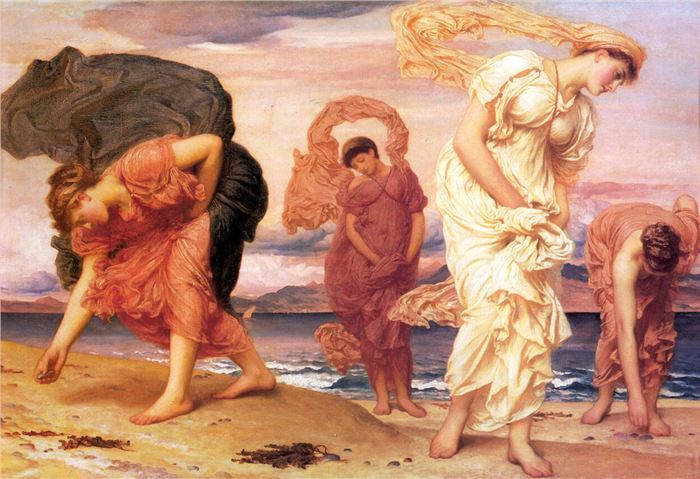 Frederic Leighton, Greek girls collecting pebbles on the seashore, oil on canvas. Collection of Pérez Simón.
Frederic Leighton, Greek girls collecting pebbles on the seashore, oil on canvas. Collection of Pérez Simón.
The San Domenico convent was built in the 13th century – where once, in the dust and past of centuries, nuns walked the cloisters in silent prayer to find peace with their God, now visitors may immerse their souls in the embrace and reconciliation of art, with gratitude for the curatorial work and love that produced the possibility of this experience. The Forlì city administration renovated the convent and reimagined it as a world-class gallery, moving their civic collection into the space and leaving some areas open for temporary exhibitions, including a gorgeous church and wide cloisters, directed by Gianfranco Brunelli. The curators have made wise use of the small cells once used by the nuns, to show intimate works, small oil paintings, watercolors, and drawings are especially sympathetic to the austere and prayer-filled rooms. Larger rooms upstairs are filled with more ambitious works. The exhibit begins the history of the Pre-Raphaelites with the vision of the ancient masters, illustrated by religious works by 13th and 14th-century artists like Bernardo Daddi, Cimabue, and Filippo Lippi, contrasting them with Frederic Leighton and Edward Hughes, who paid due reverence to Christ in the years of their devotional work. Further context is formed by works of 19th-century painters who reimagined the past and renewed the art of their time – the art of the gothic revival. Noting the shared heritage and quiet respect the artists had for their antecedents, curator Peter Trippi said, “They’re in dialogue with each other – you can feel them chatting to each other. There’s a feeling of conversation that’s so humbling.” The importance of John Ruskin, whose aesthetics shaped British art in the 19th century, is not neglected, and a dozen of his watercolors state his case. Edward Burne-Jones is well-represented by a large spread of paintings and drawings from four decades of his work, juxtaposed with drawings by Michelangelo. A pleasant sharing of the applied arts of William Morris and Company shows the appreciation the artists had for positioning their work within living spaces. The seraph heralds of Evelyn De Morgan’s angelic Aurora Triumphans announce the harmony between the Italian and the British painters with trumpets and the golden wings of heaven.
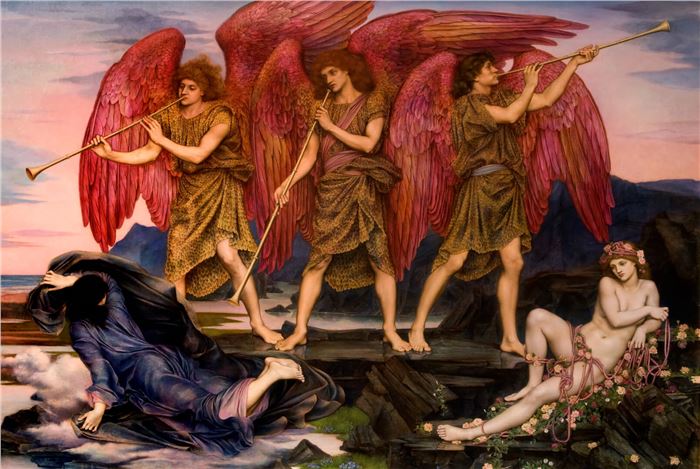 Evelyn de Morgan, Aurora Triumphans, 1886, Oil on Canvas, Bournemouth, Russell Coates Art Gallery and Museum.
Evelyn de Morgan, Aurora Triumphans, 1886, Oil on Canvas, Bournemouth, Russell Coates Art Gallery and Museum.
Greek Girls hangs comfortably on these ancient walls then, in kissing distance of its beautiful companions. Like many of the canvases in this superb exhibit, Leighton’s girls have travelled a long way, but the journey was worth the risk to be included in this superlative show of magnificent treasures. The formidable curatorial team included luminaries Cristina Acidini, Francesco Parisi, Liz Prettejohn, and Trippi, with the collaboration of Tim Barringer, Stephen Calloway, Charlotte Gere, Véronique Gerard Powell, and Paola Refice. The team hoped to reveal the profound impact of Italian art on the British Pre-Raphaelites and their followers between the 1840s and the 1920s. They have succeeded, for the debt is evident, but the glorious continuity between the centuries reveals the length and depth of delight in the themes shared by the artists – separated by time but united in intent.
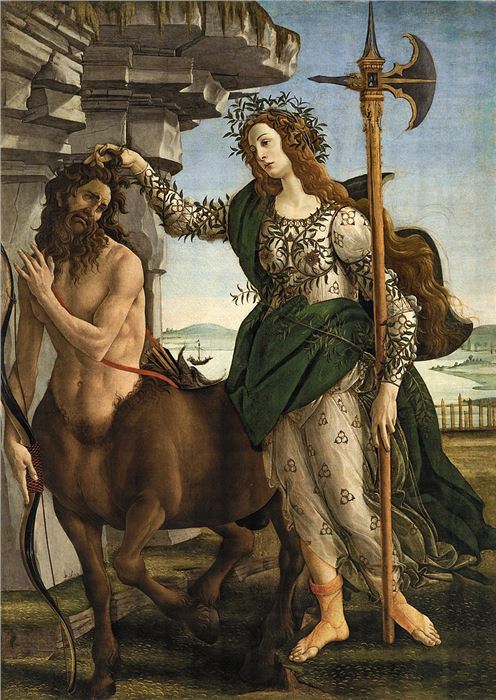
Sandro Botticelli, Pallas e Centauro, c. 1482-1483, Oil on canvas, 207 x 148 cm, Gallerie degli Uffizi.
The sensual pleasures of the exhibit in the church alone are a delight. Welshman Frederick Pomeroy’s bronze copy of Benvenuto Cellini’s Perseus with the Head of Medusa is positioned beside Sandro Botticelli’s oil painting Pallas and the Centaur, each full of grace and pagan beauty, and emphasizing the closeness of the bond between the 15th and the 19th centuries. And a room with a scattering of gorgeous women painted by Dante Gabriel Rossetti is appropriately stunning, and the artist must be smiling at the exhibit from the afterworld, for there is some pathos here. Trippi explained, “It’s so ironic that Rossetti never visited Italy – it’s unthinkable somehow – but that’s the way it worked. Italy was in his mind from his family, of course, because his father was Italian, and he saw Italian works left and right in London and Paris, but he never actually made it to Italy – and his buddy Burne-Jones made it three times!” The space is the definition of exemplary curation, revealing the depth of the debt owed by the Pre-Raphaelites to their Italian antecedents – the Rossettis hang beside delights by Jacopo Vecchio, Giovanni Bellini, and Filippo Lippi, accompanied by British artists Charles Murray – whose The Concert is a pleasant surprise. Robert Bateman’s Pool of Bethesda reveals the debt by style and subject, Christiana Herringham reveals it by devotion and duplication.
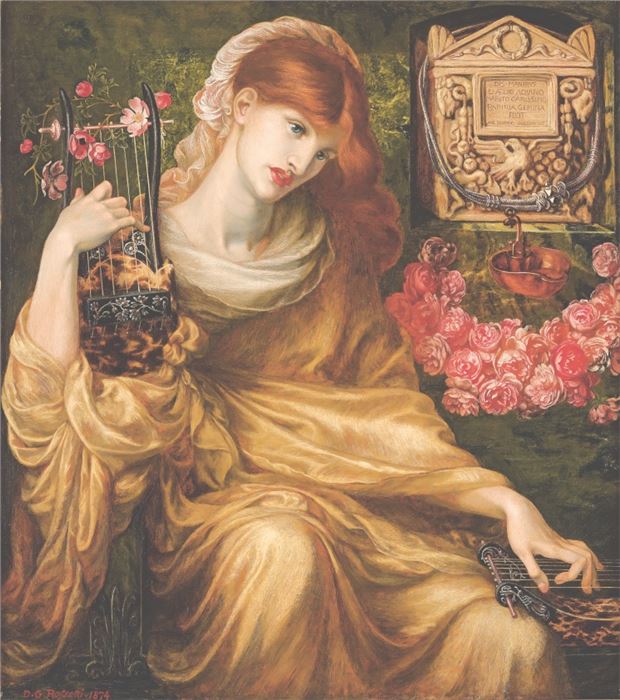 Dante Gabriel Rossetti, Roman Widow.
Dante Gabriel Rossetti, Roman Widow.
The deference of the Pre-Raphaelites to their Italian forbears is well-known, but the careful curatorial team have included a charming conclusion to the exhibition which shows how Italian artists at the end of the 19th century were in turn inspired by their British predecessors. Trippi commented, “The most famous in Italy is Giulio Aristide Sartorio, who decorated the National Parliament in Rome, he’s a household name even today, although he died over a hundred years ago, and he was very much a fan of Burne-Jones in particular, as many continental Europeans were. They were paying attention not only through visits to the UK, but also through Studio Magazine and through exhibitions of British art that were visiting the continent through the World’s Fairs, for example, or through special commercial gallery packages. So, he really fell in love with the stuff, and said so, and you can see it right there in the work. That’s known to scholars in Italy, but I don’t think the Italian public is aware of that link, and that’s why it’s such a nice coda to the show.” Sartorio’s Vestale, and his spectacular altarpiece The Wise and Foolish Virgins show his power, and his appreciation of his British brothers and sisters of the brush.
Giulio Aristide Sartorio, The Wise Virgins and the Foolish Virgins, 1890-1891, Municipal Gallery of Modern Art of Rome.
The works are wedded by wonder – both the wonder that the abundance brings to the audience with such quality spanning the centuries, and the wonder paid by the artists to the myths and legends of the past. The romantic impulse to luxuriate in the pleasures of myth and legend, and to re-tell those ancient stories in the context of the present, drove all of these men and women, and that impulse is as alive and relevant today; for although we imagine ourselves to have progressed from the earliest civilizations, we are equally as brutish, violent, and malevolent as our ancient ancestors – but equally good, creative, and compassionate – and we have much to learn from their wisdom.
“Pre-Raphaelites: Modern Renaissance” is at the San Domenico Museum, Forlì, Italy, February 24 – June 30, 2024.
For more on auctions, exhibitions, and current trends, visit our Magazine Page


